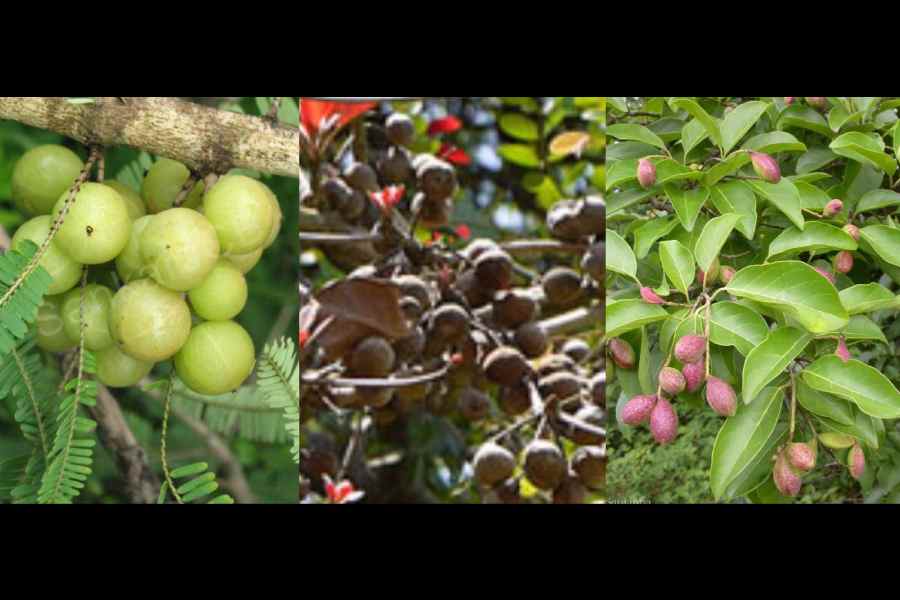Chinese scientists have stolen a march in efforts to decipher the secrets of triphala, a herbal cocktail used for centuries in traditional Indian medicine for myriad health disorders.
Ayurveda practitioners and herbal drug makers describe triphala — made from the extracts of Indian walnut, Indian gooseberry and bahera nut — as a versatile drug that can treat stomach ailments, fight inflammation, or boost immunity, among other uses. Lab and mice studies by Indian scientists nearly two decades ago had hinted that triphala also has anti-cancer effects for which evidence has since grown.
Now, researchers at China’s Southern Medical University, Guangzhou, and their collaborator in Germany have unravelled the molecular mechanisms underlying the anti-cancer effects of triphala. Their study has found that triphala triggers biological self-destruct mechanisms in oral squamous cell carcinoma, the most common among oral cancers, and suppresses cellular activity that drives the growth and spread of tumours.
Their findings suggest that triphala inactivates a key cellular pathway implicated in runaway cell growth in cancer. Triphala, therefore, could be considered as a “potential adjunctive therapeutic agent” against oral cancer, researcher Simin Li at the Southern Medical University and her colleagues said in their study just published in Phytomedicine, a peer-reviewed scientific journal.
Indian scientists familiar with triphala say the formulation’s entry into clinics would need to be preceded by rigorous human clinical trials.
But they say the Chinese study is impressive and illustrates the contrast between diving deep into mechanisms underlying traditional formulations and remaining content with claims in ancient texts and observational experience as largely practised in India.
The Chinese researchers used computational analysis to determine whether and how 24 small molecule compounds found in triphala interact or influence the activity of specific genes involved in the biological pathways of oral cancer. They also observed the anti-cancer effects of triphala on human oral cancer tumours implanted in zebrafish, intended to serve as an animal model for the cancer.
“Such experiments could and should have been undertaken in India,” said Subhash Lakhotia, emeritus professor of zoology at the Banaras Hindu University, Varanasi. Lakhotia has been exhorting the country’s scientific and ayurveda community to combine expertise to bolster the scientific credence of promising traditional formulations.
He said such research shows how ayurvedic formulations may be re-purposed for disease conditions beyond their traditional uses.
“But this can happen only through rationally-designed exhaustive and multi-pronged studies done in a systematic and unbiased manner,” Lakhotia told The Telegraph. “I hope the larger ayurveda academic community in the country pursues such studies rather than merely continuing to rely on experience-based classical treatises and fragmentary experimental studies.”
The Indian government had started a research initiative called the ayurveda biology programme more than 15 years ago that has funded projects. But Lakhotia and other scientists say the programme hasn’t gained adequate momentum or interest from the ayurveda community.
“It is unfortunate, but research on ayurveda has not progressed in India because there have been very few attempts for deep scientific insights,” said Manjeshwar Shrinath Baliga, a radiation biologist and head of research at the Mangalore Institute of Oncology, Mangalore, who has been studying triphala for over 20 years.
Baliga and his colleagues published a research last year that showed how triphala in combination with iodine can mitigate radiation-induced oral ulcerations in patients undergoing treatment for head and neck cancers.
“The Chinese study is well-planned and systematically done,” Baliga said.
Among the earliest hints of the anti-cancer effects of triphala emerged from studies by scientists at the Jawaharlal Nehru University, New Delhi, in 2005 and from the Bhabha Atomic Research Centre, Mumbai, in 2006. Both research groups had demonstrated the anti-cancer effects of triphala in mice.










